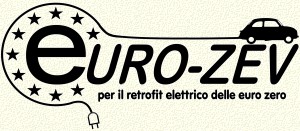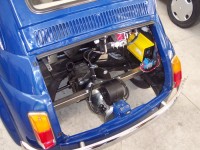
A electric Fiat 500, chronicle of the electric retrofit of an Italian myth.
I don't know about you, but every time that I see an abandoned Fiat 500 at some car demolition, I feel a stitch in my heart. The Fiat 500 is part of Italian history more or less on the level of Garibaldi, the legs of Sofia Loren and the ones of Gino Bartali. A small big idea, together with the Fiat 600, that has taught millions of Italians to drive and has brought motorisation to the masses of Italy.
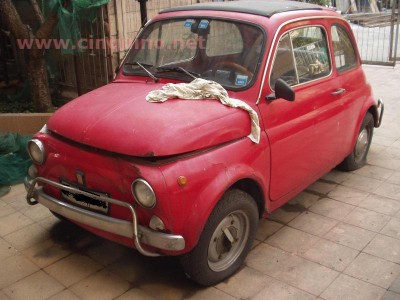
Looking at it nowadays, it does not seem such a big deal, but 40 years ago a vehicle capable of transporting a family (at least one of those with “foldable” children like mine) in the countryside, and daddy to work day in and day out, was a real revolution. From the mid sixties it has been, in many families, both the first and second family car. The one for her: this nice cute thing. Pleasant yet robust with enough space for a couple of children and the shopping of the day.
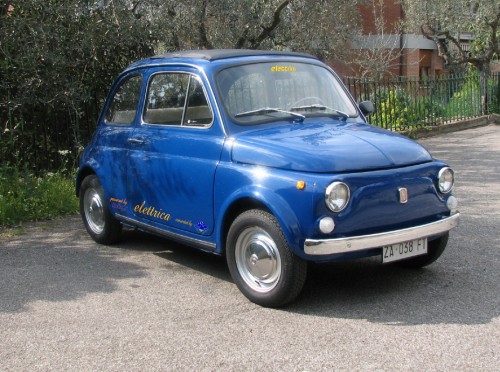
Of cause; this was millions of years ago, but today something like 300.000 fiat 500 of the 5 million made are still around. Loved and cared for, super protected from rain and Rust, the ONLY real enemy of this small car. But every year, because of legal restrictions that limits urban traffic for non catalysed cars, tens of thousands of 500 end their life ingloriously demolished or even more likely, stripped for spare parts. So, here we have another motive for bringing forward the idea of the electric retrofit. Lets look at this vehicle from the point of view of an electrical conversion.
The ideal electrical vehicle for use in the city, surroundings and for commuting should be:
*Light
*Small (short and narrow)
*Narrow front
*With an acceptable aerodynamic coefficient.
*With narrow road wheels to limit use of energy, more important here than extensive road grip.
*Economical and practical to repair from maintenance to small bumps.
The electric Fiat 500, apart from its irresistible appeal, respects perfectly all these points. Actually it's difficult to find an electric car on the very modest Italian market with the same characteristics.
*The empty weight (without batteries) is around 400 Kg.
*The Fiat 500 is the shortest and narrowest car produced in significant numbers still on the road, and it is authorized to carry 4 people.
*Likewise the front is the smallest one of all cars circulating.
*The aerodynamic coefficient, like the one of the Fiat 600, its better than one might think, thanks to the closed frontal: around 0,38 (A lot of modern small cars are less aerodynamic). It can be improved, arriving around 0,35, if the bottom of the car is sealed of with a sheet of PVC or similar in correspondence with the motor.
*The original tyres with their classic wheel rim, are, even though they are narrow, excessively deformable. When possible they should be replaced by radial pneumatics or even with the ones specifically made for electrical vehicles.
*The electrical vehicles on the market today, have notable problems with availability and cost of spare parts. Spare parts for the Fiat 500 are easily found, and even at RIDICULOUS prizes: 60 Euro for a set of headlamps, 10 Euro for a set of tail lamps, 30 Euro for a front bumper, 200 euro for a complete side door. If any of you recently have had to substitute a wing mirror on a small utility car, you know what I mean.
.
.
.
How do you do it?
In Italy it is difficult, because of the usual gordian knots of administration and bureaucracy of the “bel paese”. Knots that should be cut with the direct intervention by the legislative power. A proposal has been elaborated by ASPO Italia (www.aspoitalia.net) for an amendment to the newest legislation in this field.
...But in the meantime.
One could transform your own Fiat 500 to EV and have it authorized roadworthy by the Italian department of TÜV (The German technical approvement institute), have it registrated with German licence plates, and then finally reimport it to Italy, at the cost of some thousand Euro.
Another possibility, the one I have chosen, is to create an association for the purpose of building, testing and experimenting EV's, and then have a temporary licence plate released. You also need an insurance for this (expensive!). Then you go on the road, doing all the propaganda and lobbying necessary to have your legislator taking action.
In Italy, when you have a new idea, or a least an alternative one, and if you decide to put yourself in front of promoting it, your path is all steep uphill. I will spare you the chronicle of the numerous visits, telephone calls, explanations, administrative fees, quarrels and protests necessary, but it is possible to make it. The means to open the heavy door on its rusty hinges to the public administration, has been her: the Fiat 500. It has been ONLY when I explained what kind of car I wanted to transform to EV and why, and ONLY THEN, that the engineer at the road traffic office softened up. Thousands of lights came on in his eyes, and a smile broke down the iron curtain of the everyday bureaucrat.
Understanding this and arriving at this point, I was over the top, and by the way I must give a warm thanks to some civil servants for their direct and immediate engagement, that has permitted the first road tests of the 500.
Okay, you would say, but how do you actually convert a Fiat 500? To summarize: there is nothing difficult. What is difficult is to find someone IN ITALY that can do it, but in other countries, where legislation is less restrictive, these conversions are being done, for the better part, as a sort of advanced do-it-yourself. In fact, you need to have a certain capacity and know-how in the electro technical sector. The main obstacle, the adaptation of the electric motor to the original gearbox, can easily be overcome by one of the many companies that make mechanical adaptations and things similar. The gearbox of the 500 is, in fact, elementary, very light and absorbs only a ridiculous amount of energy. If you leave it in you can use a more efficient motor with less torque.
Yes, but HOW MUCH does it cost to convert to EV? That's a good question, and the synthetic answer is: it depends.
If you
are all into recycling, impassioned by do-it-yourself electronics, have
time, patience, will and if you should succeed, in some way to have
the thing authorized roadworthy it COULD cost like a couple of thousand
Euro. This could be less if you are so clever as to make your own controller,
cannibalize a motor from a dismissed lift, find the electronics here
and there and you succeed in putting it all together without being fulminated.
More rialistic, the cost would be in the order of anything from around
5000 Euro, for a good garage conversion using branded quality electronics
to around 12.000 Euro using exceptional quality pieces and “exotic”
batteries like lithium ion polymers (the ones I used for the 500), lithium
ions, Zebras, nickel iduris etc.
At this point, if you are not doing it yourself, you have to add the cost of the artisan that will, on an average, do the work in a week or so. At this point it's important to understand that these are the expenses of one prototype, and that these expenses decrease A LOT if numerous equal conversions are made. This is actually the statutory goal of the newly born Euro-Zev association.
Its important to understand that, apart from the batteries, the cost of the conversion is a one time expense. Am electric induction motor have a rating of around 100.000 hours use, traduced in something like 3.000.000 Km.
The revision consists of replacement of the motor bearings, and then its ready again for other 3.000.000 km. All in all you can say that a conversion of an endothermic vehicle to EV also means a conversion (or better: abandoning) of ideas and concepts that we are familiar to with traditional cars.
No more service checks, oil filters, spark plugs, injectors, radiators, exhaust silencers, catalytic filters etc. The expenditure for the conversion is rapidly gained by the low cost of using the vehicle. EVs are around 3 times as efficient as normal cars (around 6 times in city traffic). You save money in repairs, and in Italy you pay less tax for a EV and assurance is only 50%. (around 200 Euro) a year.
How is it to drive the EV and how much autonomy do you have?
Again, it depends!! Among other things it depends on the motor one has chosen, on its torque, on the quality and quantity of batteries on board etc. The electric 500 is conceived and build to have performances similar to the original configuration, and for the maximum efficiency within the limits of budget and time that we had decided.
The technical configuration is:
electric
motor: Landi DC, 13 KW 96 V separately excited.
Batteries: Kokam Lithium-polymer 96 V 100 Ah with a total of around
9.6 Kwh
Controller Phoenix 600 A with capacity of energy retrieval during motor
braking (up to 3 Kw)
Converter DC/DC: Landi (necessary for the 12 V circuit)
Charger: Zivan 20 Ah.
In practice a compromise between economy, velocity of construction, specific competence of the constructor and performances in terms of efficiency and autonomy. The first results emerging from the first test run are: 14 Km. covered without economising and with abrupt acceleration and sudden braking: 1,2 KWh consumed. Translated into comprehensive terms: with the energy compared to a litre of petroleum we could cover something like 115 Km.
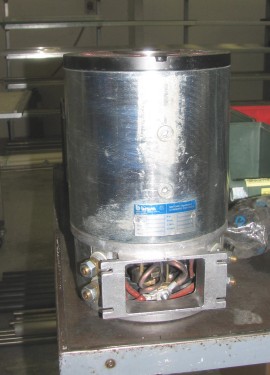 .
.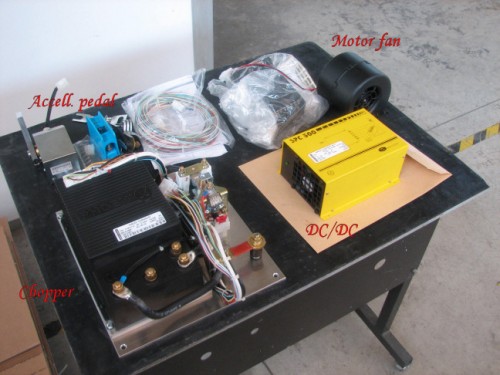
How do you drive it?
You drive
it as you would a normal 500. We have maintained the original gearbox
with all its advantages and defects. Changing gears isn't without problems:
You need to re-learn how to synchronize the electric motor with the
gear (obligatory with the 500). If you're not in a hurry, you can easily
start up in the 3rd gear, if not you start up in the second. You rapidly
go to the 3rd and keep it there until you stop. Only if your speed is
over 65 Km/h. it's convenient to use the 4th. In some testing I did
on REAL highways, with turns, hills etc. I reached speeds in eccess
of 100 Km/h. On the real highways at decent velocities ( 80 km/h) and
in the real traffic I succeded in covering 85 km between two charges
(the Siena-Grosseto distance, check by yourself). There are still some
fine tuning to do but the result is amazing.
When driving it's funny to observe the look in the eyes of the people
standing at the traffic light crossings. Especially when you speed away
with a whistle...
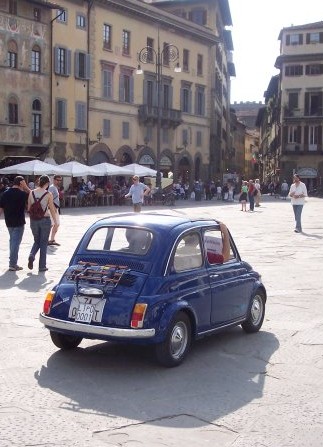
The electric conversion of the Fiat 500 is the result of the voluntary work of Riccardo Falci of the Egraf Lineadue in Camignano. The car is financed and owned by Pietro Cambi from Fiesole.
Link: "The Post Peak car" Article for "The Oil Drum" 10 November 2007
For more pictures click here for photo album 1 and photo album 2. Sorry, the explanations are only in Italian.
The EURO-ZEV
organization are at the present moment:
Pietro Cambi: President, financier, author and owner of the Fiat 500.
Ugo Bardi: Theoretical of electrical motorisation. Professor of physical
chemistry at the University of Florence. President of ASPO italia.
Massimo De Carlo: Consultant on electrical vehicles and technologist.
Riccardo Falci: Constructor and supporter.
Giovanni Pancali: Moral support.
Corrado Petri: Electronic engineer, director of the automation sector
of Calp.
Ringo Reenberg: publicity, web, public relations and foreign contact.
